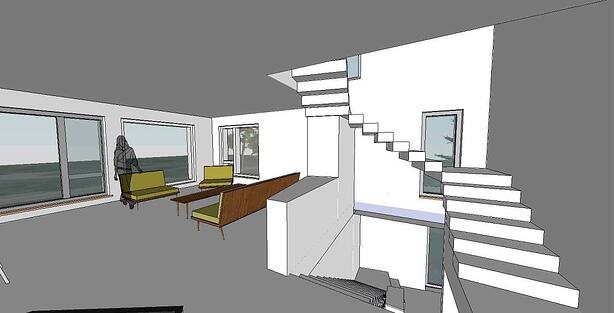Things have been moving slowly with my home replacement project so there hasn’t been much news. We are advancing towards spring construction (if Vermont’s winter ever ends), but are facing some unexpected challenges. The thing that we are finding most surprising about this process is that there is no roadmap. Originally we had thought that our architect and builder would guide us through the process, but they have been unable to provide much information regarding financing. Here are few of the things we are dealing with now:
Cost
We had planned to roll the soft costs into our loan (like in commercial construction). It turns out that we cannot get a loan that includes costs for the architect and structural engineer.
The minimum cost to build a high performance home is $200/square foot. We do not want or need a large or fancy house, but we do want the views of Lake Champlain and the Adirondacks that are accessible from upper floors on our property. This means that the house is designed with a public second floor (kitchen, sitting, dining and living rooms) and a smaller third floor with a walk out roof deck. This will add value to the house for us and future owners, but also adds to the square footage. The tear down of our current house, perfunctory renovations on the Shack in Back where we plan to live during construction and fixing the site drainage adds thousands to the project cost.
Loans and Banks
We’ve been talking to banks since the beginning and it seems like the sand is shifting. What we do know is the loan to value ratio (LVR) is a key component of the
decision around financing. Even without including the soft costs, the project, payoff of existing mortgage plus contingency is running in the mid-six figures. We have heard three different LVRs from different banks and for different loan products. A 60% LVR is needed for one banks’ internal lending if no comps can be found. A 70% LVR would necessitate an appraised value of $1 million (this is required for another bank’s 5/1 ARM construction loan) and an 80% LVR is allowed by one bank if there are three comps. This would mean either the appraised values or the loan amount would vary by over $300,000 depending on the availability of “comps”!
Appraisers are just beginning to learn about the value of high performance homes. Fortunately we have Jeff Gephardt and Efficiency Vermont who have been working to increase appraiser familiarity with the value of these homes. However, the banks have said we cannot pick our appraisers, so we may not end up with someone who has received training in appraising high performance homes, which might make it even harder for them to find comps.
Fees
It seems like the bank and closing fees for our loan are even worse than those pesky and mysterious fees that are part of many 401(k) plans. No one can tell you what they are in advance. How hard would it be to simply publish a fee table? We are looking at between $8,000 and $20,000 of closing fees - not a small range.
One lender cannot give us an appraisal until we have a contract in place. The contractor doesn’t want to put a contract into place until he has prepared his qualified price. The contractor cannot prepare the qualified price until the architect completes the pricing set. We signed a contract with the contractor based on the schematic design set with a reasonable contingency so we can keep moving toward spring construction. Change orders, should they be required, won’t be in the loan.
Cats
Cats and construction just don’t mix. I had planned to put off getting new cats until after the house was built. But then the mice ate the wiring harness in my car ($2,000) and I live-trapped 23 rats in the fall so I broke down and got two kittens. The kittens (nearly cats now) are doing a great job controlling the rodent population in the garage and barn. But, where do they go during construction? These girls love to be out on the property hunting and I don’t think anyone will survive trying to keep them in for the duration. Obviously during tear down and earth works they will be in, but once construction starts, they will probably be outside and will hopefully not be killed by their innate curiosity.
The next time I blog we will have overcome these challenges and the new house will be taking shape. Stay tuned!








